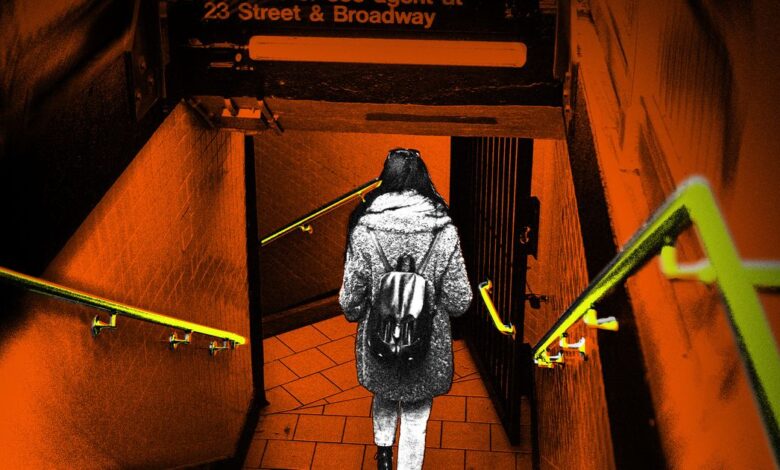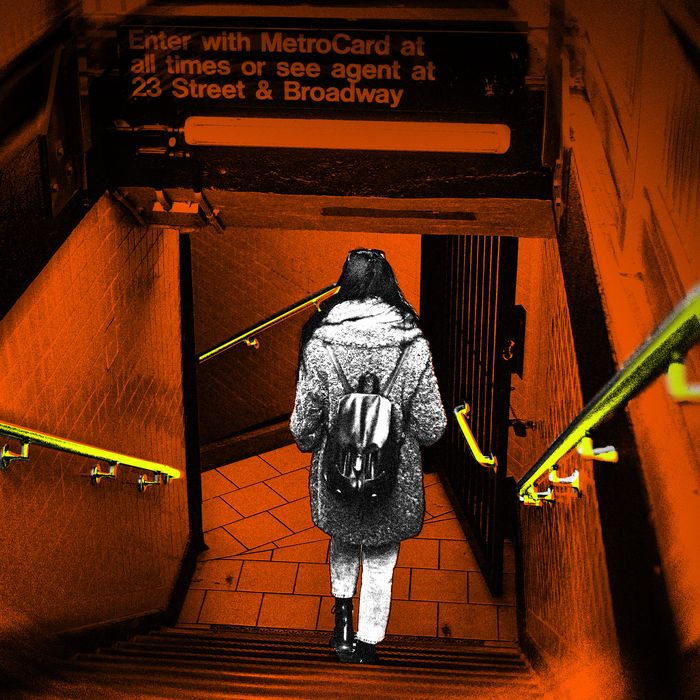The Kids Who Need Therapy For Subway Anxiety


Photo-Illustration: Curbed; Photo: Getty
I rode the subway with my daughter on her first morning commute to high school last September, from the Upper West Side to Queens — though she begged me not to and then made me promise to not sit next to her. I saw plenty of other parents doing the same: trying to look nonchalant as their teens, wearing Docs and Herschel backpacks, ignored them. The ride was blessedly uneventful.
Now, after months of traveling solo, my kid has become practically immune to the delays, oglers, track rats, and characters she encounters on her way to school — even “starfish guy,” who gave her a start the first time she saw him lying spread eagle on the Times Square platform, naked save for a “diaper-looking pair of underwear,” she says. She quickly learned to follow the lead of the deadened adults who step deftly around him or, if it’s really crowded, over his limbs. “He doesn’t move, but you know he’s alive,” she assures me, “because he’s not there in the afternoon, and then he’s back.”
But there are many kids who have not become jaded to the uneven thrills of the underground. And lately, I’ve been hearing from fellow parents that their tweens and adolescents are experiencing subway-related anxiety, often to the point of refusing to ride and sometimes requiring therapy. It likely doesn’t help that many of their parents — once fairly carefree daily subway riders — tend to ride less frequently post-pandemic thanks to hybrid work schedules and, in some cases, car purchases.
Kristi lives in Hell’s Kitchen and has a 14-year-old daughter named Anna who takes the subway only occasionally, usually when friends can convince her to join them on an outing. “She has, like, true anxiety,” says Kristi. “She’s terrified of someone falling in. She’s terrified of crazy people, of the things she sees on the news, of the shootings and stabbings. It almost makes her want to leave the city.” While Kristi barely notices when “people are acting weird,” she says Anna “can work herself up to a full-on panic attack. She gets hyperfixated on it.”
Anna never liked the subway, but trying to readjust to taking it post-pandemic has made her anxiety worse. “A lot of the fear is about falling in and being pushed onto the tracks,” Kristi says. On the rare occasions that Kristi can get Anna onto the subway lately, “she has a death grip on my arm like when she was a baby.”
While it can sometimes feel as if subway-pushing incidents are on the rise, they’ve actually dropped by a lot, from 29 people in 2022 to 17 people in 2023. Transit-system crime overall also fell during that same period (by 8.2 percent, from 191 to 208 incidents), as did complaints of major subway crimes (down 25.9 percent, or 54 versus 40 incidents), according to NYPD statistics. This year, however, that trend does look like it’s reversing; in the last full week of January, crime was already up 54.1 percent compared to the same period in 2023. Either way, perceptions of danger persist. In July, a Siena College poll found that one in three New Yorkers feared they would soon be victims of a violent crime.
Kristi grew up in the suburbs and moved to New York when she was 18. “I used to get followed on the street and duck into delis, but that was the way of life of a young woman in Manhattan,” she says. When Anna talks to her about her subway anxiety, Kristi encourages her to try to push through it, but Anna tends to avoid her trigger instead. She does her best to stay in their neighborhood and rides the bus rather than the subway anytime she can.
Therapists tell me that kids today are more apt to share their worries with their parents, which prompts their parents to accommodate their anxiety or to seek treatment for it. (I talked to one mother whose daughter is in a short-term residential-treatment program for anxiety, including subway related.) The longstanding “buck up” parenting method — which boils down to “this is New York, get used to it” — is outmoded. Experts say it’s a positive development with a hitch: Kids can wind up with more insight into mental health than they can emotionally manage.
“When I have 9- and 10-year-olds talking to me about ‘dissociative process,’ I’m like, ‘Okay, too much!’” says Marilyn Siegel, a therapist in private practice in Greenwich Village, of her precocious clients. “Young children and teens are getting a lot of mental-health advice off of TikTok, which has impacted how they navigate the world.” She tells me that kids have a basic understanding of dozens of mental-health diagnoses, which leads to self-pathologizing and self-diagnosis, often inaccurately. Siegel has always seen subway anxiety in her young clients, but it’s much more pronounced since the pandemic (several patients have full-on agoraphobia) because many kids stopped socializing and going out, and they’ve yet to recover that muscle. One patient “is always begging her parents for an Uber,” she says, and the parents of another client hired a duo to help their daughter get on and off the subway. One person accompanied her at the entrance and Siegel waited for the teenager at her destination station.
“It’s, like, so much to be taking the train right now,” says Brooklyn mom Samantha. Her 9-year-old daughter, Dahlia, has a long daily commute to dance classes and performances in Manhattan. Samantha vented to a parenting listserv recently: “She starts crying, gets frantic, and begs to not be on the train. Later, she says, ‘I know I’m safe now, it’s just that now I have that image in my head of that man without pants who was leaning in and making kissing sounds and I can’t get it out of my head.’”
Samantha has been a regular straphanger since moving here as a teen and says it’s “definitely fair to say I’ve not experienced this level of a daily mental-health crisis before.” She says Dahlia frequently has tears in her eyes while commuting. “But I can’t be taking a $70 Uber,” Samantha stresses, adding, “I don’t want to shield her from the realities of the city she lives in — you raise your kid in the city because you want them to live in a shared space.”
Lisa, who lives in Brooklyn, was working up to letting her 12-year-old son ride solo. But then, on one of their daily hourlong rides to and from his ballet class on the Upper West Side, they heard someone screaming, “He has a knife! He has a knife!” The emergency brake was pulled as their train entered the next station. Everyone ran out “and tons of police were running with their hands on their guns,” Lisa recounts. Fearing a stray bullet, they waited behind a staircase, eventually leaving and learning that no one had been arrested or injured.
“But he was really scared by it, and from that point on he was shivering every time we walked into the subway, looking over his shoulder, saying, ‘Maybe we can take an Uber,’” she says. “I could see him clench his teeth and tense up and look over his shoulder in the station … He was in this state of high alert.” Speaking with his school counselor and playing Wordle together on the commute eventually eased his anxiety. Then he announced, “If I had my own phone, I could do this trip by myself.” “He got the phone at Christmas, and that was really what got him over it. It took a year and a half,” Lisa says.
Manhattan psychotherapist Liz Morrison says that most of her young clients’ subway-related anxieties come from trains suddenly stopping and going dark for long stretches between stations. “They usually panic because they are alone and don’t know who to get help from,” she says. Therapist Kristin Reale, who sees New York City patients via telehealth, says track flooding is also a significant factor. “I think with the weather events, it’s like one hit after another — they’re just getting out of the pandemic, and they’ve lived with the awareness of climate change. Now their awareness isn’t just theoretical.”
Morrison typically teaches teens to cope using cognitive-behavioral therapy. Under her care, kids learn to identify their feelings and breathe deeply, and then make “tool kits” containing sensory objects like globs of slime or fidget spinners — items to carry with them “that can kind of ground them” in their bodies and hopefully ward off a panic attack. Sometimes Morrison also tries exposure therapy, which gradually reintroduces subway use with the goal of “getting on and then off after one stop,” she says.
CBT helped Jonah, a 13-year-old Brooklyn boy, overcome his subway fears, which were initially prompted by a string of incidents: train delays, floods, reroutings, and disturbing encounters, like when an “erratically”-behaving rider screamed at his mother, calling her “a white devil,” says his mom, Gail. A therapist instructed Gail to equip Jonah with “a lot of distracting busy boxes for travel, filled with fidgets and games,” she says, since “you don’t want to feed the beast or make them think they have some sort of control, because they don’t.”
Kristi has only just begun considering therapy for Anna’s track-shoving fears, particularly since it’s still unclear where she’ll wind up going to high school. “We could drive her,” she notes, “but we’re waiting to see what the hideous congestion pricing will be.”
The names of some sources have been changed to protect their identities.




